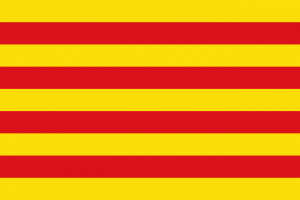Language/Catalan/Grammar/Noun-Gender-and-Plurals
| ◀️ Definite and Indefinite Articles — Previous Lesson | Next Lesson — Numbers 1-100 ▶️ |
Introduction[edit | edit source]
Welcome to the lesson on noun gender and plurals in Catalan! In this lesson, we will explore an important aspect of the Catalan language that will greatly expand your vocabulary and sentence-building skills. Understanding noun gender and how to form plurals is crucial for effective communication in Catalan. So, let's dive in and explore this fascinating topic!
Table of Contents[edit | edit source]
Noun Gender in Catalan[edit | edit source]
In Catalan, like in many other Romance languages, nouns have gender. Every noun is either masculine or feminine, and this gender classification affects the forms of articles and adjectives that accompany the noun. While there are some general rules to determine the gender of a noun based on its ending, it's important to note that there are exceptions and irregularities. Let's explore the different endings and patterns associated with noun gender in Catalan:
Masculine Nouns[edit | edit source]
Most Catalan nouns ending in -o are masculine, such as "gat" (cat) and "llibre" (book). However, there are exceptions like "mà" (hand) and "via" (way), which are feminine. Additionally, nouns ending in -or, -e, and -i can also be masculine, like "professor" (professor), "pare" (father), and "amici" (friends).
Here are some examples of masculine nouns in Catalan:
| Catalan | Pronunciation | English |
|---|---|---|
| gat | /ɡat/ | cat |
| llibre | /ˈʎi.bɾə/ | book |
| professor | /pɾu.fɛˈsoɾ/ | professor |
| pare | /ˈpa.ɾə/ | father |
Feminine Nouns[edit | edit source]
Most Catalan nouns ending in -a are feminine, such as "casa" (house) and "porta" (door). However, there are exceptions like "pa" (bread) and "dia" (day), which are masculine. Additionally, nouns ending in -ció, -sió, and -tut can also be feminine, like "informació" (information), "decisió" (decision), and "salut" (health).
Here are some examples of feminine nouns in Catalan:
| Catalan | Pronunciation | English |
|---|---|---|
| casa | /ˈka.zə/ | house |
| porta | /ˈpoɾ.tə/ | door |
| informació | /im.fuɾ.mə.siˈo/ | information |
| salut | /səˈlut/ | health |
Forming Plurals in Catalan[edit | edit source]
Now that we have a good understanding of noun gender in Catalan, let's move on to forming plurals. In Catalan, nouns can be pluralized by adding an -s to the end of the word, similar to English. However, there are also some irregular plurals that we need to be aware of. Let's explore the different ways to form plurals in Catalan:
Regular Plurals[edit | edit source]
Most nouns in Catalan form their plurals by adding -s to the end of the word. For example, "gats" (cats) and "cases" (houses).
Here are some examples of regular plural nouns in Catalan:
| Catalan | Pronunciation | English |
|---|---|---|
| gats | /ˈɡats/ | cats |
| cases | /ˈka.səs/ | houses |
| llibres | /ˈʎi.bɾəs/ | books |
| portes | /ˈpoɾ.təs/ | doors |
Irregular Plurals[edit | edit source]
Just like in many other languages, Catalan also has some irregular plurals. These plurals do not follow the regular pattern of adding -s to the end of the word. Let's take a look at some common irregular plural nouns in Catalan:
| Catalan | Pronunciation | English |
|---|---|---|
| home | /ˈɔ.mə/ | man |
| homes | /ˈɔ.məs/ | men |
| dona | /ˈdo.nə/ | woman |
| dones | /ˈdo.nəs/ | women |
| fill | /ˈfil/ | son |
| fills | /ˈfils/ | sons |
| filla | /ˈfi.ʎə/ | daughter |
| filles | /ˈfi.ʎəs/ | daughters |
Cultural Insights[edit | edit source]
Understanding noun gender and forming plurals in Catalan is not only important for language proficiency but also offers valuable cultural insights. The distinction between masculine and feminine nouns reflects the gendered nature of the language and its connection to societal norms and perceptions. Additionally, the irregular plurals provide a glimpse into the historical development of the language and its rich linguistic heritage.
Did you know that the Catalan language has its roots in Vulgar Latin, the popular spoken form of Latin during the Roman Empire? Over the centuries, Catalan has evolved into a distinct Romance language with its own unique grammar and vocabulary. Today, it is spoken by millions of people in Catalonia, Valencia, the Balearic Islands, and other Catalan-speaking regions.
Practice Exercises[edit | edit source]
Now that we have covered the basics of noun gender and forming plurals in Catalan, it's time to put your knowledge into practice! Below are some exercises to help you reinforce what you have learned:
Exercise 1: Gender Identification Identify the gender of the following nouns and indicate whether they are masculine or feminine.
- casa
- llibre
- professor
- porta
Solution:
- casa (feminine)
- llibre (masculine)
- professor (masculine)
- porta (feminine)
Exercise 2: Plural Formation Form the plural of the following nouns:
- gat
- fill
- dona
- casa
Solution:
- gat - gats (cats)
- fill - fills (sons)
- dona - dones (women)
- casa - cases (houses)
Conclusion[edit | edit source]
Congratulations on completing the lesson on noun gender and plurals in Catalan! You now have a solid understanding of how noun gender works in Catalan and how to form plurals. This knowledge will greatly enhance your vocabulary and sentence-building skills, allowing you to express yourself more accurately and fluently in Catalan. Keep practicing and exploring the fascinating world of the Catalan language!
Sources[edit | edit source]
Other Lessons[edit | edit source]
- Cardinal Numbers in Catalan
- Dative Case in Catalan
- Common Prepositions
- Conditional and future tenses
- How to use the Modal Verb Must in Catalan
- Accusative Case in Catalan
- Plural
- Introduction to pronouns
- Passive voice
| ◀️ Definite and Indefinite Articles — Previous Lesson | Next Lesson — Numbers 1-100 ▶️ |

